
The ferns are a group of vascular plants that reproduce via spores and have neither seeds nor flowers. They differ from mosses by being vascular, i.e., having specialized tissues that conduct water and nutrients, and in having life cycles in which the branched sporophyte is the dominant phase.
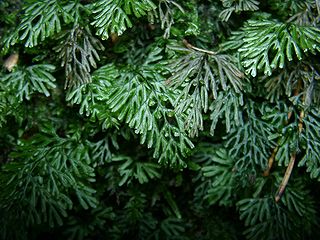
The Hymenophyllaceae, the filmy ferns and bristle ferns, are a family of two to nine genera and about 650 known species of ferns, with a subcosmopolitan distribution, but generally restricted to very damp places or to locations where they are wetted by spray from waterfalls or springs. Fossil evidence shows that ferns of the family Hymenophyllaceae have existed since at least the Upper Triassic.
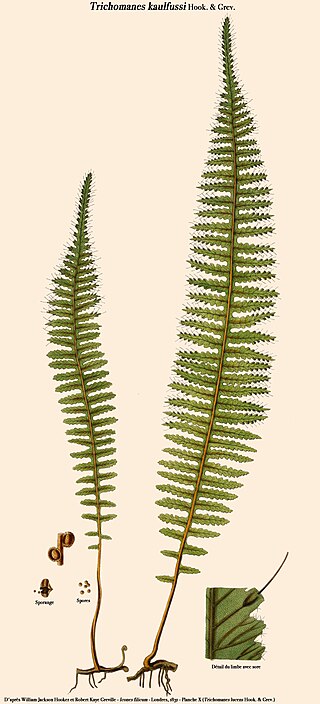
Trichomanes is a genus of ferns in the family Hymenophyllaceae, termed bristle ferns. The circumscription of the genus is disputed. All ferns in the genus are filmy ferns, with leaf tissue typically 2 cells thick. This thinness generally necessitates a permanently humid habitat, and makes the fronds somewhat translucent. Because of this membrane-like frond tissue, the plant is prone to drying out. “Filmy ferns” in the taxa Hymenophyllaceae grow in constantly wet environments. Many are found in cloud forests such as “Choco” in Colombia. There are also members of the taxa that can grow submersed in water.

Asplenium rhizophyllum, the (American) walking fern, is a frequently-occurring fern native to North America. It is a close relative of Asplenium ruprechtii which is found in East Asia and also goes by the common name of "walking fern".

Hymenophyllum nephrophyllum, the kidney fern, is a filmy fern species native to New Zealand. It commonly grows on the forest floor of open native bush. Individual kidney-shaped fronds stand about 5–10 cm tall. In hot weather they shrivel up to conserve moisture, but open up again when the wet returns. This species has very thin fronds which are only four to six cells in thickness. In the Māori language they are also called raurenga.

Vandenboschia speciosa, synonym Trichomanes speciosum, commonly known as the Killarney fern, is a species of fern found widely in Western Europe. It is most abundant in Ireland, Great Britain, Brittany, Galicia, Canary Islands, Madeira and the Azores, but is also found in other locations including France, Spain, Portugal and Italy. It is a relict endemic European species with a disjunct distribution, having had a much wider distribution before the climate changes of the Tertiary and Quaternary periods.

Asplenium trichomanes, the maidenhair spleenwort, is a small fern in the spleenwort genus Asplenium. It is a widespread and common species, occurring almost worldwide in a variety of rocky habitats. It is a variable fern with several subspecies.

Amauropelta noveboracensis, the New York fern, is a perennial species of fern found throughout the eastern United States and Canada, from Louisiana to Newfoundland, but most concentrated within Appalachia and the Atlantic Northeast. New York ferns often forms spreading colonies within the forests they inhabit.
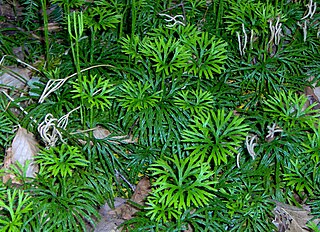
Diphasiastrum digitatum is known as groundcedar, running cedar or crowsfoot, along with other members of its genus, but the common name fan clubmoss can be used to refer to it specifically. It is the most common species of Diphasiastrum in North America. It is a type of plant known as a clubmoss, which is within one of the three main divisions of living vascular plants. It was formerly included in the superspecies Diphasiastrum complanatum. For many years, this species was known as Lycopodium flabelliforme or Lycopodium digitatum.
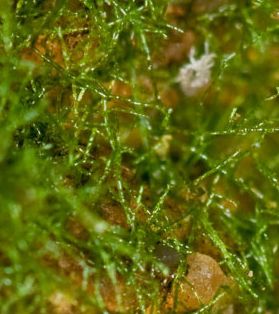
Crepidomanes intricatum, synonym Trichomanes intricatum, is known as the weft fern. The genus Crepidomanes is accepted in the Pteridophyte Phylogeny Group classification of 2016, but not by some other sources. As of October 2019, Plants of the World Online sank the genus into a broadly defined Trichomanes, treating this species as Trichomanes intricatum.

Polystichum lonchitis is a species of fern known by the common name northern hollyfern, or simply holly-fern. It is native to much of the Northern Hemisphere from Eurasia to Alaska to Greenland and south into mountainous central North America. It has stiff, glossy green, erect fronds and grows in moist, shady, rocky mountain habitats.

Hymenophyllum australe, commonly known as austral filmy fern, is a relatively large rupestral and epiphytic fern, indigenous to eastern Australia and New Zealand. It belongs to the unique Hymenophyllum genus, which are characterised by their thin membranous fronds that are seldom more than one cell thick, with the exception of regions over and around veins. Hymenophyllum australe is distinctive in that the fronds are typically thicker than other Hymenophyllum species, often being up to 2-3 cells thick.
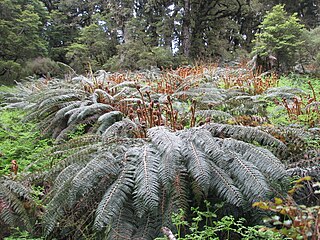
Polystichum vestitum, commonly known as the prickly shield fern or pūnui (Māori), is a hardy, evergreen or semi-evergreen ground fern.
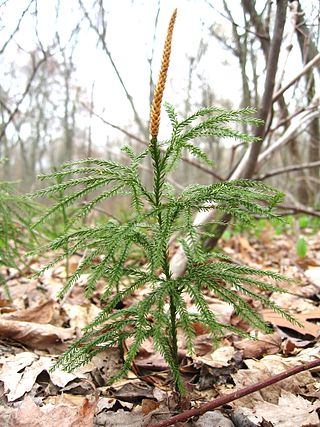
Dendrolycopodium obscurum, synonym Lycopodium obscurum, commonly called rare clubmoss, ground pine, or princess pine, is a North American species of clubmoss in the family Lycopodiaceae. It is a close relative of other species such as D. dendroideum and D. hickeyi, also treelike. It is native to the eastern United States and southeastern Canada from Georgia to Minnesota to Nova Scotia. It grows in the understory of temperate coniferous and deciduous forests, where it is involved in seral secondary succession, growing in clonal colonies some years after disturbance has occurred. It has also been found in Japan, Taiwan, Korea, Russian Far East, and northeastern China.

Gymnocarpium robertianum, the limestone fern or scented oakfern, is a fern of the family Cystopteridaceae.

Asplenium resiliens, the blackstem spleenwort or little ebony spleenwort, is a species of fern native to the Western Hemisphere, ranging from the southern United States south to Uruguay, including parts of the Caribbean. Found on limestone substrates, it is named for its distinctive purplish-black stipe and rachis. A triploid, it is incapable of sexual reproduction and produces spores apogamously. First described by Martens and Galeotti in 1842 under the previously used name Asplenium parvulum, the species was given its current, valid name by Kunze in 1844. Several similar species are known from the tropics; A. resiliens may have arisen from these species by reticulate evolution, but precise relationships among the group are not yet certain.

Anchistea is a genus of leptosporangiate ferns in the family Blechnaceae. It has only one species, Anchistea virginica the Virginia chain fern, which has long creeping, scaly, underground stems or rhizomes giving rise to tall widely separated, deciduous, single leaves. In contrast, the leaves of Osmundastrum cinnamomeum, which can be mistaken for A. virginica, grow in a group from a crown. Also in contrast to O. cinnamomeum the leaves are monomorphic without distinct fertile fronds. The lower petiole or stipe is dark purple to black, shiny and swollen, the upper rachis is dull green. The leaf blade is green and lanceolate, composed of 12 to 23 paired, alternate pinnatifid pinnae. The pinnae are subdivided into 15 to 20 paired segments that are ovate to oblong. The lower rachis is naked for about half its length. The sori or spore-producing bodies are found on the underside of the pinnae and are long and form a double row which outlines the major veins of the pinnae. In common with all ferns, A. virginica exhibits a gametophyte stage in its life cycle and develops a haploid reproductive prothallus as an independent plant. The spores are produced in red-brown sori which line the spaces (areolae) between the costa and costules. Further photographs can be found at the Connecticut Botanical Society and Ontario Ferns websites.

Hymenophyllum tunbrigense, the Tunbridge filmy fern or Tunbridge filmy-fern, is a small, fragile perennial leptosporangiate fern which forms large dense colonies of overlapping leaves from creeping rhizomes. The common name derives from the leaves which are very thin, only a single cell thick, and translucent, giving the appearance of a wet film. The evergreen fronds are bipinnatifid, deeply and irregularly dissected, about 3 to 6 cm long, 2 cm across with dark winged stipes. In contrast to the similar H. wilsonii the fronds are more divided, flattened, appressed to the substrate and tend to have a bluish tint.
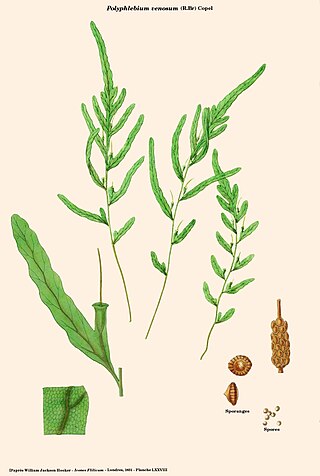
Polyphlebium venosum, the veined bristle-fern or bristle filmy fern, is a fern in the family Hymenophyllaceae. It is only found in wet forests, mainly growing as an epiphyte on the shady side of the soft tree fern, Dicksonia antarctica. It also grows on logs, trunks of trees and rarely on trunks of Cyathea species or on wet rock-faces. It is found in the wetter parts of Eastern Australia and New Zealand. P. venosum has poor long-distance dispersal compared to other ferns due to its short lived spore. Notable features of Polyphlebium venosum include it being one cell layer thick, 5–15 cm in length, having many branching veins and a trumpet shaped indusium.

Hymenophyllum rarum, the narrow filmy-fern, is a species of fern from the family Hymenophyllaceae. This thin-leaved fern is commonly found in New Zealand and Tasmania, growing in patches on rocks and is epiphytic on trees and tree ferns, growing in moist gullies or rainforests. A rather drought tolerant species often found at exposed sites ranging from coastal to montane areas. Forming extensive, interwoven and creeping patches with its thin long (creeping) rhizomes sparsely covered in red-brown hairs, easily recognised by its membranous grey-green fronds, the smooth margins of the pinnae, ultimate segments and indusia; and by the sunken sori in the uppermost segments of the uppermost pinnae. The species can be found throughout Tasmanian rainforests as well as occurring in New South Wales, Victoria and New Zealand on the North and South Islands as well as, Stewart, Chatham and Auckland Islands.





















